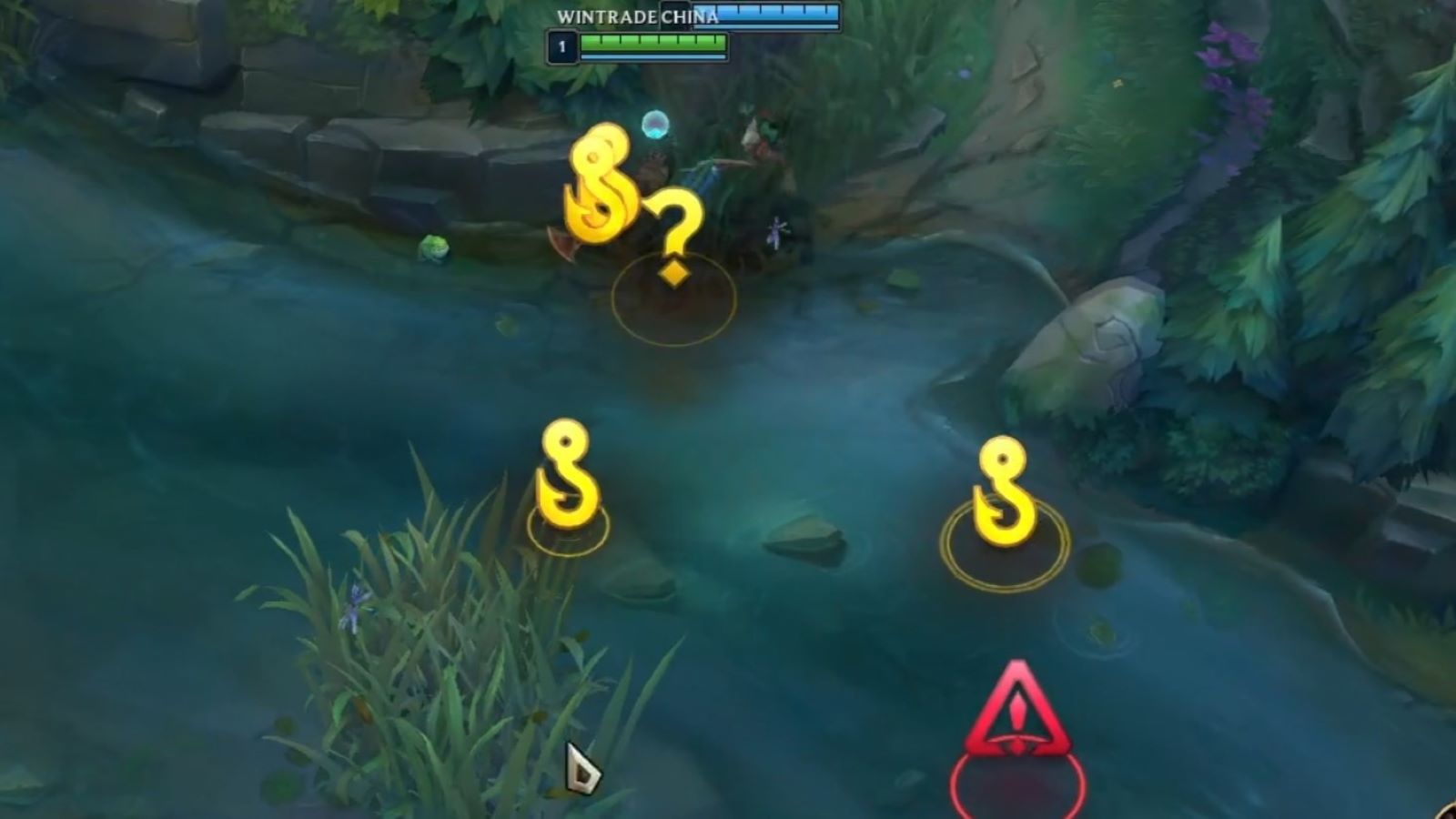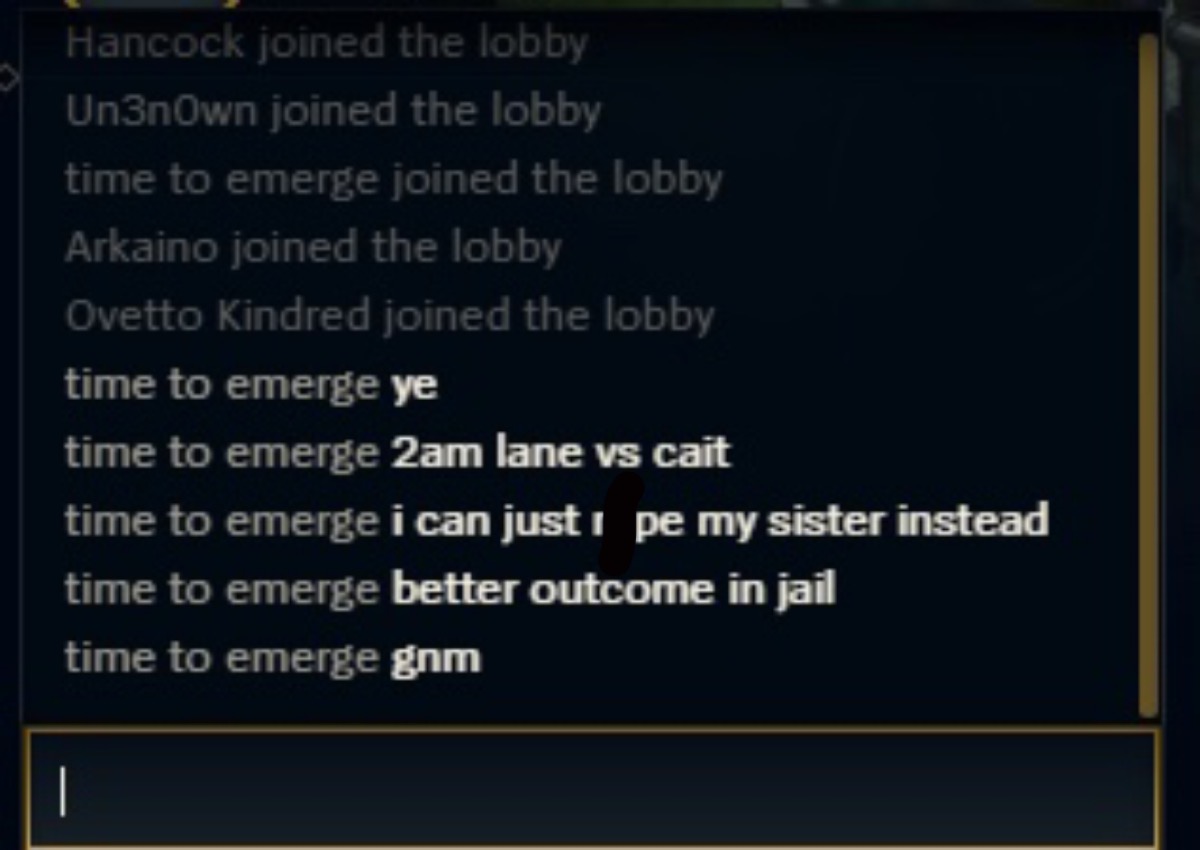
After writing several draft posts for my last blog, I have decided I might as well write it on League of Legends. This is the grave I have dug for myself, the hill I have chosen to die on, and I will take it in stride. With every new year, so too does a new season of League of Legends commence with major changes to the meta to keep the game dynamic. We’re currently in pre-season 13 and not only is the gameplay awful, Riot Games has decided it does not want League to be toxic anymore. An updated ping system to improve communication, chat-bans on “bad” words and action-based pop-ups. What could possibly go wrong?
The old state of the art
There is no force more unstoppable than a League player who is incredibly pissed off at a teammate and wants to make it known. Combine that with the League playerbase consisting of mostly-male mostly-straight either-white-or-korean and you get a creative scheme of toxicity that includes threats, slurs and the friendships we’ve made along the way. Typically, players will express their malcontent through the in-game chat and verbally express just how much they dislike you. However, after a certain amount of n-words and threats, you will get banned from the game. Players can also opt to run it down’,int, or grief, which are all different methods of playing terribly on purpose to make the enemy stronger and your team weaker, just because you want to make your allies’ day worse. This can be detected by Riot, and can get you banned. Without risking their own account or losing the game, players will then use the question-mark ping, traditionally used when an enemy’s location is unknown, to question-mark your bad plays. Spam-pinging someone is not only incredibly annoying due to the pop-up, it also expresses how impressed you are by their incredible gameplay, now with none of the slurs!
The new and improved toxicity
Riot has decided that the root of toxicity has to be that players cannot properly communicate in-game. It does not have a voice-chat like their game Valorant, and typing in chat the whole time keeps your hands off your attack-keys and mouse so you can’t play. Riot has now introduced a chat-ban, where players immediately get banned from using the game’s chat when they use a word that Riot has flagged as bad (such as slurs and sexual terms.) Not to worry, because the new bait ping is a hook… presumably tied to a rope…

Can’t call someone a slur and tell them what they should do with a rope and a stool? Riot games has got your back, now you have a fast and easy ping to express just that! Players have taken advantage of this and it’s so awful there is no choice but to laugh. I love this game. In fact, I’m interrupting writing this article to get on League.
Three hours later
League players excelling at being toxic no matter the circumstances is an interesting online phenomenon. No matter the restrictions on the chat and explicit toxicity, players will find a way. It is an interesting subculture within the gaming community, one not celebrated but defining of a game and its player base nonetheless. It is painfully obvious that no amount of restrictions on toxic behaviour can hold it back, which makes it seem like toxic behaviour is not inherent to the game’s chatting and communication system or the general gameplay. The issue then inherently lies in the playerbase, the digital community that has created this culture. So, why are people so desperate to be toxic in League? While understandable that you get frustrated at certain scenarios, there is a difference between “Oh good heavens, this is awful” and:

I also get tilted. I get gamer rage, but when I do, I mute the entire in-game chatting and pinging system, and after the game is done, I log off. Upon interviewing a friend about toxic behaviour, which he was a star at in the past, he expressed it is due to build-up anger. He expressed League as some kind of punching bag due to lack of having one in real life.
Friendly advice, learn English, stop being a dumb *beep* and play the game instead of talking, you *beeping* dog
A censored statement by my friend in League’s in-game chat, one among many for which he got banned
The question that then arises is why such a substantial amount of young men do not seek help for their anger issues, but rather prefer taking it out online through verbal abuse and discrimination. Now, I don’t want to sound like a feminist because league of legends players hate feminism, but perhaps the toxicity in League is then an unexpected result of a patriachal society where men’s mental health is underrepresented. Recent years have shown an emergence of awareness on toxic masculinity, the idea that men are supposed to be dominant and aggressive. The idea that men are supposed to be strong, that men cannot show weakness or express emotions such as grief and sadness. Well, through anything other than aggression, because the patriarchal ideal shows a man strong, self-reliant and dominant. League toxicity ticks all the boxes for toxic masculinity and the problems in the game are thus (in)direct results of this.
If this emotional repression due to not having a proper or healthy output for emotion is at the root of toxic gamer behaviour, then there is little Riot can do but promote mental health awareness. Despite league of legends players being described as perpetually online, offline society has cultivated this online society and toxic League players are not an isolated problem inherent to the game, a possibility I doubt has been considered by Riot Games. The entire phenomenon shows that online and offline society are intertwined and cannot be analysed independently, an interesting conclusion derived from the tragic phenomenon of **** ******** *****



Thank you for this post. I think it’s generally pretty common for gaming communities to be intertwined with toxicity, particularly when it comes to League of Legends or World of Warcraft, however, it always blows my mind just how toxic it really is. I agree with you – I think most of the rage stems from the patriarchal society what we live in – emotional men are often categorized as week, so anger and all-consuming rage seems to be top masculine emotion, particularly in games. I guess it’s better that they express it in the gaming world rather than the real life, but it still horrifies me to read all of those rage comments and always makes me think that if these men/boys think this is acceptable, they must think that violence against other people (i.e. the r*pe comment) in real life can also be justified. Scary stuff. Fingers crossed they either grow out of it or get the help that they necessary need, as I doubt that anyone with a clear mind would even make comments such as these. Anyways, thanks again! It’s a very interesting and relatable post that really does combine the gaming world and the reality. Good job!
Thank you for your thoughts! It is common and I hope that through opening the conversation we can, as a community, reduce toxicity !
Hi Hi, Thank you for the post. I know how toxic the fanbase can be from Riot Games, especially League of Legends. I just disable my chat in League and Wildrift, so I don’t have to read the comments, which can be unhelpful sometimes, but luckily most of the time I do play with friends through Discord. I do avoid ranked games tho, since the toxicity of the players can make me bit scared and ruin the gaming experience. I guess that is also depends on the rush players get and out through violence, which is not the healthiest way. I don’t think that the violence can be taken away entirely, since players can indeed find new creative ways to act on rudeness. Very relatable post!
/mute all /mute all /mute all
I don’t play in ranked either, I cannot handle how horrible people get. Stay safe out there
As someone who absolutely loved Arcane from Netflix, I will probably never get into League of Legends, simply because of this toxicity…
But thank you so much for pointing out toxic masculinity! Men too are victims of patriarchy and they absolutely do not deserve to bottle up their emotions only to put it forward in anger and violence.
arcane is amazing and league does not reflect how cool arcane is. On the off-chance you get a vi and a jinx together in a game, you get one second of ‘haha cool’, but that’s all. Stick to arcane for your own sanity <3
Interesting blogpost. Although I don’t have any point to make on the point about LoL players separating their online and offline aggression, but I do want to give Riot credit for one good thing, aside from the overwhelming amount of bad descisions they have made; but you already covered those well. This is the fact that they are making more pings to create clearer communication that does not involve the chat function. As you and another commenter have already mentioned, but the /muteall function is a core part of the LoL experience and a lot of people do this, especially in ranked, to avoid toxicity. This ofcourse has the result of a lot of people not using the chat function in a game where communication is important. So I do want to give credit in that sense, even if the new pings can be used not according to intented use.
i love mute all with all my heart and I agree that we should give some credit to riot for at least trying to improve communication! However, I don’t think lack of transparent pings were the root of the problems in league that riot seeks to solve. Riot should just delete the game /j
Thank you for your post, I really liked how you linked the phenomenon to the outside world and the whole online gaming community as well, which made me think of some points.
Firstly, how I see a stark contrast between most team -shooter games (LoL is a shooter, right?), and Splatoon for the Nintendo Switch. I’m using Splatoon as an example as that is the only game I have played myself rather than watching on the sidelines.
Although there can be annoying people, toxicity is almost never found since you only have four lines of communication to choose from (Where, here, ouch, gotcha). Furthermore, when watching streamers play the game, they always “ridicule” the people getting visibly angry at the game or make a joke of themselves whenever they raise their voice slightly since it it “just a game”. I think it’s interesting I have only seen this in the Splatoon community.
Secondly, although many female players avoid the chat or use the mute all button, do you think some female players enjoy these games because they can behave in a toxic manner? Since living in a patriarchy can be so limiting, I imagine built-up anger to generate within you as well and I would see LoL or any other online team-shooter as a great way to release this anger because “everyone else is doing it as well”.
Lastly, I think it is interesting you mentioned LoL players hate femminism, the phenomenon that would allow them to express their emotions in real life rather than releasing their pent up anger online.
I think it is a difference in demographic. Correct me if I’m wrong, but I do not believe that splatoon is a game dominated by the Heterosexual White Male? Female players, lgbt players, players of colour, typically seek safe spaces from the things they face in the real world and so it would make sense for them not to be toxic in games, as it would defeat the purpose of having a safe space. I would guess it’s a difference in demographic, correct me if I’m wrong, though!
Personally, I don’t use league as a way to release my pent-up anger nor do I know any girl that does. If anything, I make it a point to be extra-nice and extra-feminine to the point that it catches players completely off guard. Maybe that is my way of extracting revenge on the patriarchy. Either way, isn’t it interesting the way different video games reflect different aspects of humans? Almost like mirrors.
I have a strong feeling with every word you said! And the situation in Asia can only be worse since being rude seems to be considered part of masculinity, a mode of the norm and rules. And it feels even worse if they treat you in a “good” way, just because you are a girl. I feel unequal in this case. However, the problem is fundamental should be the way they(male groups in general) treat each other, and the solution shouldn’t be me joining that norm for equality.
This was great to read. I made the right decision to stop playing league of legends after season 4 (after i made the wrong decision to start playing it 3 years prior to that), and it’s interesting to see what they’ve done for the communication and toxicity. I honestly think that whatever implementation is in place, there will be toxicity no matter what. The only way to truly stop any extreme forms of it is to disable chat of course, but that is also a very important requirement to actually communicate in the game. It’s nice to see more communication pings but of course they’re also being used to hint a lot of subtle things, like you said, you cant easily stop someone who’s fuming playing league, so any taunt the game has can set you off.